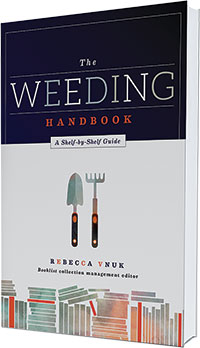
Library weeding gets a bad reputation, thanks in part to weeding horror stories.
In 2013, Highland Park (Mich.) High School was accused of throwing out a large collection of history materials, including some rare items, which had been cultivated over a 50-year period. That same year, the Urbana (Ill.) Free Library discarded nearly 10,000 items, apparently just based on age, rather than condition or use. The discarding was done at the director’s command—while the head of adult services was on vacation. In 2014, there were weeding news stories from school libraries in Racine, Wisconsin, and Boston. The media in Chattanooga, Tennessee, had a field day interviewing the former director of Chattanooga Public Library, who was more conservative about weeding, after the new director weeded almost half the collection over two years. Patrons in Albany County, California, formed their own protest group when they noticed that most of the shelves in their branch libraries were suddenly only half full.
What usually happens is that a disgruntled (sometimes justifiably so) staff member sets off the alarm to the public about what’s happening behind closed stacks. Or worse, a patron spies a dumpster full of discarded material and immediately jumps to the conclusion that the library is enacting a modern-day book burning. Employees who do not feel their concerns are being heard or their professional opinions are being considered may decide they have no choice but to become whistle-blowers. Patrons who do not understand the selection or weeding process are understandably alarmed when they see a mass number of items removed from their local library.
It pains me to read about these situations for a number of reasons. First and foremost, because I’ve been there—on the dark side.
In 2001, while working for Chicago Public Library, I was accused by a local politician of destroying books while working on a massive and much-needed weeding project at a regional branch. I was part of a team experienced in collections, and we had a plan to move, replace, and discard a large amount of material. Unfortunately, that plan did not include communicating to the public what was going to happen. Nor did we do a very good job of communicating with the branch staff, who felt that they were being pushed aside by a group of outsiders. The experience opened my eyes to the need for an open path of communication and the need for staff buy-in. Luckily, I have also worked on weeding projects that went very smoothly, even when working with large numbers of books.
I also hate to hear bad weeding stories because they raise the hackles of patrons, taxpayers, and book lovers everywhere and lead them to believe that weeding is never a good thing. Hearing such horror stories brings on the knee-jerk reaction that no book should ever, ever be discarded, which simply isn’t feasible. And, finally, these stories are painful because they illustrate that there are still plenty of librarians and administrators who do not understand the fundamentals of weeding.
Ideally, a library wouldn’t need to perform drastic weeding projects. If a collection is weeded on a regular basis, a section at a time, and maintained well with new materials, it rarely requires a large, hard-to-ignore weed. When a major project is needed, it should be planned out carefully, and communication is a key part of that planning. It’s not particularly difficult to get the message out to your staff and patrons.
Communicating with patrons
If a large weeding project is planned, get the word out before the work commences. The director should make a statement on the library’s website, in the library newsletter, or to the local press. Take command of the situation rather than let speculation and rumors take hold. The general reasons for weeding should be discussed, as should some details about how the project will work and affect patrons (i.e., patrons may notice empty ranges while the evaluation process is going on; patrons should expect to see replacements coming in X weeks). It’s important for everyone to keep in mind that weeding isn’t always about ridding the shelves of unwanted materials—sometimes it’s about getting fresh new copies of the exact same titles.
In the case of ongoing weeding, there doesn’t need to be a formal announcement, but staff should be prepared to answer questions from patrons (“Why are half the graphic novels missing from the shelf?” “I’m sorry for the inconvenience! We’ve pulled that section, and it’s currently on a book cart in the workroom while we check how much use the books get and search for new ones to add to the collection. Is there something I can grab for you?”)
In either case, use positive terms instead of negative ones when talking about weeding, and never complain to patrons about bad materials that were on the shelf. Instead, explain that the library is making room for new materials, making the shelves easier to navigate, and replacing outdated information with current information.
The way you dispose of discarded material will also have an impact on how the public reacts.
If the public knows that material is being reused or recycled, they may feel better about the weeding process overall. If materials have to be thrown in the trash, the library director needs to make a statement regarding the types of materials that are being thrown away (outdated medical and law texts and books in unsalvageable condition are good examples to use), so that everyone is clear that “perfectly good books” aren’t being destroyed.
Transparency in action

Until recently, the Milwaukee School of Engineering (MSOE) devoted a page on its website to weeding at the library. It included the following language:
“What if you see a book that you do not feel should be weeded? Tell us! Stop by the library and talk with one of the librarians or send us an email.
Because of the many factors that are implicated in the decision to remove a book, each case is different. However, the library staff will seriously consider the wishes of all members of the MSOE faculty, staff, or student body who inform us that the book should remain in the library collection. To repeat, no book will be permanently removed while it is a candidate for removal. Books will only be permanently removed after the MSOE community has had a sufficient opportunity to comment on the lists of candidates for removal.
In addition, MSOE described, in very simple terms, its general guidelines for weeding:
“In deciding whether or not a book is a candidate for weeding, the MSOE library staff [members] attempt to answer the following questions:
- Is the book’s content outdated or largely outdated?
- What do members of the faculty say? Do faculty members recommend that the book be kept?
- What do members of the staff say? Do staff members recommend that the book be kept?
- What do students say? Do members of the student body recommend that the book be kept?
- How many times has the book circulated? Has it circulated within the last five years?
- Is the book irrelevant to the needs and interests of customers?
- Has the book been superseded by something else? Has a subsequent edition been added? Is there a better book that should be obtained instead?
- Is the book physically damaged and beyond repair?
- Can selected books be obtained easily and quickly through interlibrary loan?
- Is the book requested by other libraries via interlibrary loan?
- Is the book considered a “classic” contribution to the field (and therefore, it should be retained)?
- Is the book a second copy? Are there good reasons to retain multiple copies of a book?”
Putting out statements like that to the public can help patrons understand that weeding does not happen in a vacuum and that it is a necessary task. Weeding is not a mechanical process. There is emotion involved; there is thought involved, and it takes the same amount of skill to build a collection as it does to cull one. Successful projects will include keeping staff and patrons informed to help avoid speculation and negative assumptions.

 REBECCA VNUK is editor for reference and collection management at Booklist and cocreator of the popular blog Shelf Renewal. Her most recent library position was as adult services director at Glen Ellyn (Ill.) Public Library. Vnuk is author of Read On … Women’s Fiction (Libraries Unlimited, 2009) and Women’s Fiction Authors: A Research Guide (Libraries Unlimited, 2009), and coauthor (with Nanette Donohue) of Women’s Fiction: A Guide to Popular Reading Interests (Libraries Unlimited, 2013).
REBECCA VNUK is editor for reference and collection management at Booklist and cocreator of the popular blog Shelf Renewal. Her most recent library position was as adult services director at Glen Ellyn (Ill.) Public Library. Vnuk is author of Read On … Women’s Fiction (Libraries Unlimited, 2009) and Women’s Fiction Authors: A Research Guide (Libraries Unlimited, 2009), and coauthor (with Nanette Donohue) of Women’s Fiction: A Guide to Popular Reading Interests (Libraries Unlimited, 2013).

This is so wrong. When did libraries become entertainment centers for the masses? The role of a library is to preserve and protect our written history. I might not check out a book for years, but one day it might be invaluable in helping me learn something or in solving a problem. Maybe this is news to you but not all information is routinely revised and updated. Original text is invaluable in knowing the source or basis of information. Often quoted “facts” may be wrong or in error because qualifying data presented in the original text was not copied into subsequent editions. Thanks to you, people have no way to trace and check the original source because all of the old editions have been weeded out. As for donated books, those with bookplates from bygone eras, how do you think the donors would feel if they knew that someday their books would be thrown out with the trash? Some people spend their lives collecting books and they make a donation in their will so that their legacy will live on. But it’s all a farce. Instead of the library protecting the collection, it’s deemed obsolete and worthless. Those books were entrusted to the library, to be accessible to future generations, and you violate that trust.
Holy cow, this response came out longer than I planned.
Mike, you have some good points but I think you’re also not seeing the entire picture. The role of libraries has expanded quite a lot in recent years – part of our job (yes, I’m a librarian) is to act as an information repository, but we wear a lot of other hats as well. Some people come to the library because they need access to computers and don’t have or can’t afford internet or a computer at home. Some people need a quiet place to study and don’t have that at home for whatever reason. And that doesn’t even take into account all the help librarians themselves provide for people – I’ve acted as search engine for people, as 411 to find people phone numbers, helped people get the tax forms they needed, helped people find a new book or movie that they’ve never read or watched before, helped people find information on becoming a citizen… the list goes on. My point is, people come to the library for a lot of reasons, not just to check out books.
With regard to weeding books, I definitely think there’s such a thing as going too far. I was in library school when the story about the Urbana Free Library weeding came out, and we ended up using that as a case study on how NOT to do this kind of thing.
There are a lot of reasons why libraries get rid of books and other materials. Should we keep a book if it has coffee stains? If the pages stick together? What if it’s got mildew in it so bad that your eyes start watering as soon as you crack the book open? Sure, ideally we’d replace those copies, but what if there aren’t any replacements available? What about a book that nobody has checked out for five years? Is it not fair to say that such a book isn’t relevant to the needs and interests of the community anymore (if it ever was)? What about a book that has never checked out at all?
Typically, libraries have a policy for how they do this process. And it’s a process they’ve always done – we can’t keep every book or we’d run out of space, and our shelves would be so crowded that nobody could find anything. The article lists a lot of factors that typically go into that process, though I’d like to add that the exact criteria generally varies from subject to subject. After all, as you say not all information is obsolete and worthless just because it’s older. But some is. A book on history or art (or art history) could still be useful as long as it’s in good condition even if it’s 30 years old. But on the other hand, do you really think a library should still carry books on, say, Windows 95? I would be astonished if many Windows 95 computers are still running, and the demand for books on them would be pretty much nonexistent. What about books on science or medicine, where older information may be not only outdated, but flat out wrong?
The line has to be drawn somewhere, if for no other reason than because libraries only have so much space to keep stuff. They’re also chronically underfunded (you don’t wanna know what the library job market is like right now), so they’re in a constant battle to be as useful to the community as possible to keep their funding from being cut further. Libraries see more use than ever when the economy is bad, but at the same time that’s when people can least afford a property tax increase to help the library pay its own bills and keep its services up to date. And that is why libraries have to be more than book collections, why they also sometimes function as “entertainment centers for the masses,” as you put it. By having all the newest popular fiction and movies (and increasingly video games as well), we’re continuing to strive for increased relevance in people’s lives so that we can also continue to be that repository of information and knowledge.
If your reason for posting was to say that libraries gutting their collections by dumping hundreds and thousands of books and other items at a time is bad, I honestly can’t disagree with you. But careful pruning of the collection to get rid of stuff that’s not useful anymore is necessary for the library to function and always has been.
John – thank you for your very detailed reply. I know that some books do need to be weeded when they become damaged, stained, or a health risk due to mold. And I can agree that dated computer books have little use, although an auction of such books several years ago in Silicon Valley generated $$$ because some of those original, obsolete, books are collectable. Are you aware that there is a whole branch of study regarding industrial archeology? How can research into the production methods of the past be conducted if libraries toss out primary source material? I know that much technical information does not go out of date and it can be several decades before that info/data is required again.
As for all of the services provided by libraries, that represents a failure of our society to fund libraries adequately and to make sure that their primary mission (to preserve and make accessible books) is maintained. The reason why libraries have become dominated by computers and job placement services is because city governments are too cheap to fund these activities directly. Libraries have stepped up to fill that role, and it’s wrong in my opinion because it removes the burden from local government. Excessive weeding of books is not the solution to limited funding, it’s a symptom that libraries are underfunded and stretched too thin in providing services that should be provided by others.
That something might be useful to someone at some point is why my in-laws’ house is stuffed full of old useless stuff!
Most public libraries are not archives. If we kept everything, we’d have no room for new stuff. We like to say in my system that books must earn their places on the shelves. They can’t just sit there unused indefinitely.
I get that someone at some point might want an old computer book or travel guide, but it just isn’t possible to keep such things in that unlikely event some researcher might come in years from now and want the books. We have to serve all the public and have things that most of the population can use now. For example, the public wants study/tutor rooms. The libraries have to make room for those. If that means paring down the collection of stuff nobody’s reading anyway to make room for those rooms then so be it.
It’s all a delicate balancing act.
Angela – I’m very familiar with the house full of old useless junk reference. When my grandmother moved out west she had the junkman haul out tons of bronze plates and statutes from her basement. You see, my grandfather was the foreman of the foundry at Yale and Towne and they often overproduced to keep the men working. I would love to have some of that material today, as would her grandchildren, but it’s gone forever due to her “it’s junk” attitude.
The same goes for much of the material being weeded today. Each library goes through a decision process that results in the wholesale elimination of books. Public libraries are weeding more and more because they are being forced to take on more work that should not be their responsibility. In trying to provide service to as many people as possible, I contend they have lost focus and purpose. It’s is rare that I can use a library for research because the books are no longer available.
There are, and have been for decades, last copy initiatives in place. The books are not gone forever, as there are designated repositories to house such works you have defended. There are ways to borrow most items or at least have access to them. More and more are digitized and even open access online.
However, you have brought up a very good point, this all costs money. If libraries are eliminated, so is the access to information no matter how old!